Chromatic Alterations in Josquin's Basies Moy
Mike Krzyzaniak
A few notes in the four-voice version of Josquin's 'Basies Moy' must be altered chromatically, using both 'Musica Ficta' and 'Musica Recta', applied according to the prescripts of contemporary theorists. These prescripts, although straightforward in their application to the four-voice version, are drastically confounded by the additional two voices in the six-voice version. Some chromatic alterations that must be made in the four-voice version must be made differently or not at all in the six-voice version. These differences substantially alter the character of the piece.
In measure 2 of the four-voice version, the high Superius (comes) enters with this melody, shewn here against the Bassus comes (i.e. the pair of voices that would be heard together if this were sung as a duet without the canonic imitation) (complete scores are below):

In measure 3, the G is a suspension, which resolves to the F in the middle of the measure. The semi-minims E and F are an embellishment of the resolution, so that the basic unembellished Superius is just sol fa sol, thus: 1

In his treatise 'Ars Discantus', Jean de Muris (c1290-c1350) tells us that the fa must be sung as F♯. He says: "Quandocumque habetur in simplici cantu sol fa sol, hoc fa susteineri debet et cantari sicut fa mi fa", or "Whenever sol fa sol is encountered in simple song, the fa should be held up and sung like fa mi fa."2 The interval fa - mi was the only way to denote a half-step in the mediæval hexachord system, so he means that sol fa sol should be sung as a half-step, which is accomplished by raising fa chromatically. He illustrates this with the following example: (Note that the symbols♮and ♯ are used interchangeably by theorists at this time.)

Here, of course, he is talking about monophonic music ("simplici cantu"), but he gives another related rule for polyphonic music. Reexamining the first example above, we see a minor sixth in measure 3 expanding to an octave in measure 4. Of this, Muris says: "Quandocumque aliqua sexta imperfecta... immediate habet post se aliquam octavam ..., illa tunc sexta imperfecta debet perfici ♮duro", or "Whenever any imperfect [i.e. minor] sixth... has immediately after itself an octave..., then that imperfect sixth must be perfected [i.e. made major] with hard♮[i.e. raised to resemble ♮ in the hard hexachord, as opposed to ♭ in the soft hexachord]." 3 He then gives the following example, labeled "Sixth having an octave after itself":
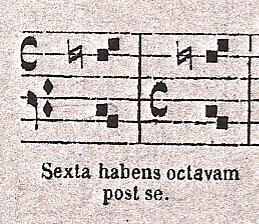
which also indicates that the F in the measure 3 should be raised.
Muris' Italian contemporary Marchetto da Padua confirms that the F must be raised to "perfect" the sixth, even if the result is highly chromatic, and he gives the following example:4

Here, the last measure in particular shows the F being raised.
It may be argued that Jean de Muris and Marchetto da Padua both predate Josquin by about 200 years. We may, however, find some information in more contemporary literature that suggests that their prescripts are still applicable. Pietro of Aaron, for instance states his eighth rule of counterpoint thus: "La ottava Regola è, che volendo andare a una consonanza, sempre si debbe pigliare quella che allei è più vicina", or "The eighth Rule is that, when wanting to go to a consonance, you must always take the one which is closest."5 Although his meaning is not immediately clear, his following list of possibilities clarifies that he means "Perfect consonances should always be preceded by the closest imperfect consonance". Amongst his examples, he names the following:
- La sesta minore discendendo alla Quinta (the minor sixth descending to the Fifth)
- sesta maggiore inanzi l'Ottava.(The major sixth before the Octave)
- La decima minore tornando all'Ottava. (The minor tenth returning to the Octave).
So, on Aaron's advice, seconded by Muris and Marchetto, we will raise the F to F♯, which in the 4 voice version produces this:
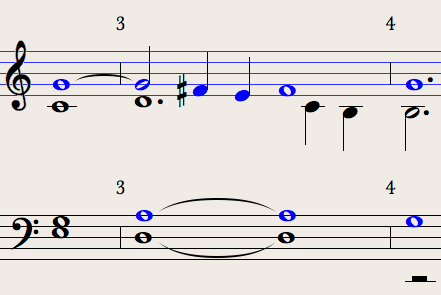
which is satisfying enough. It is what is David Fallows recommends in the 'New Josquin Edition',6 and it is what Edward Wickham's ensemble 'The Clerks' Group' sings in the four-voice version (sung down a whole step).11 Let us see how this bides in the six-voice version:

Yikes! Now there is an augmented octave between F♯ in the Superius against F♮ in the additional lower parts. Zarlino explicitly forbids this in book three of his treatise "Istitutione Harmoniche". He says "...se noi porremo la chorda ♯ posta in acuto tra la c & la d per l'uno dei gli estremi della ottava; & la chorda C posta nel grave per l'altro estremo; averemo una Ottava Dissonantissima", or "if we put the note ♯ between c and d acute [i.e. c♯ 4] at one extreme of an octave; and the note C grave [i.e. c♮ 3] at the other extreme, we will have a Very Dissonant Octave."7 He then goes on to say: "Questi & tutti gli altri intervalli mostrati disopra sono Dissonantissimi: & non si debbono porre nei Contrapunti; Perche generarebbono fastidio all'Udito", or "These and all of the other intervals shewn above are Very Dissonant and must not be put into Counterpoint; Because they create annoyance upon being heard." He then gives this table of 'forbidden intervals':

which clearly shews an augmented octave between C♮ and C♯ in measure 6. This presumably applies to all augmented octaves in general, including the F♮ - F♯ at hand.
One might speculate that the problem of the augmented octave could be solved by simply raising the F♮ in the lower voices to F♯. It will, however, be noted that the F in the upper Bass part is preceded by a C♮ (shewn in red above). Raising the F to an F♯ would therefore create a leap of a tritone, which is widely forbidden by theorists. Tinctoris, for instance, says "while the human voice may possibly use a tritone in scalewise progression, to use it, however, in a leap is either difficult or impossible..."8 Zarlino, too, explicitly forbids augmented fourths and diminished fifths, both scale-wise and by leap, and includes several examples in his table of "Forbidden Intervals" (above), of which perhaps measure 8 is the most relevant.
We could continue working backwards, trying to correct these problems with more accidentals, but the further we go, the more problems arise (raising the C to C♯, for instance, creates a diminished octave with the low Superius, which is also forbidden by Zarlino). We may, therefore, consider leaving the entire passage unaltered in the six voice version, despite the first rule that necessitated raising the F in the Superius to F♯ to begin with. This seems like the most satisfying solution, because it avoids dissonance entirely. Edward Lowinsky confirms this decision. He says "One must distinguish between a grammatical and an ornamental use of musica ficta. Ornamental I would call... the raising of the seventh note in an ornamental clausula:

"Such ornamental use is optional; at times ... C♮ fits better into the context. At any rate, to sing or omit such a sharp will not distort the grammar of sixteenth century harmony."9 Even if Lowinsky's views on the subject are generally controversial, this particular view is further confirmed by by Dr. Smijers in the the 6 voice version in "Josquin Werken", in which F♮ is suggested (through the omission of editorial markings).10 This is also what Wickham sings in his recording.11
So, to review the choices in measure 3: In the four-voice version it seems as though the F must be raised; in the six-voice version it seems as though it must not be raised. If it is going to be raised in measure 3 of the four voice version, its counterpart in the dux (the c in the low cantus in measure 2) may just as well be raised.
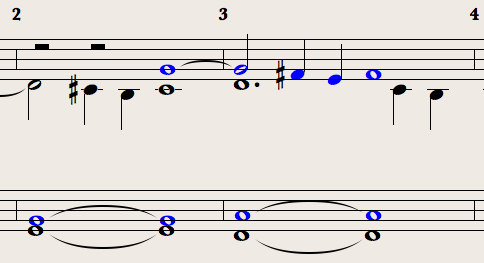
Like this, the passage is replete with major sixths and tritones, which, modern listeners may describe as sounding very 'major', or 'tonal', and the resolutions of the tritones very 'directed'. In the six-voice version, not raising these pitches will create a passage replete with minor sixths and perfect fourths and fifths, which modern listeners may describe as being 'minor' sounding and less 'directed'. Although this language is asynchronous, the aural effect is presumably not: each version has a distinct character. Furthermore, because the piece is both canonic and repetitious (ABAB), any one alteration is likely to be head as many as 4 times throughout the piece. Because the piece is brief, the distinct character manifest in a few measures like these quickly becomes pervasive.
Another passage that is nearly identical to measure 3 occurs at measure 37. Because this is effectively the penultimate measure, modern performers are more compelled to raise the F in the Superius in the 6 voice version, because it is like the third of the dominant triad in a V-I cadence. Edward Wickham, for instance, in his recording of the six voice version, has the high Superius sing an F♯, against an F♮ in the Bassus parts, despite their F♮ in the analogous place in measure 3.
Although this satisfies our modern expectations of cadences, there does not seem to be anything in the contemporary literature that makes the case for raising the F at cadences more compelling than raising it at any other location within the piece. In fact, Aaron, in a chapter entitled "About the Termination or Cadence Ordained for the Soprano", gives an example of possible cadences which contains the following:12
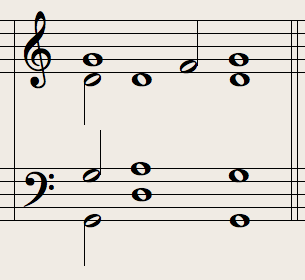
which is very similar to measure 37. On the one hand, his aforementioned "Eighth Rule" implies that the F should be raised here. On the other hand, he says "...because the tones [i.e. modes] are composed of various species of intervals, ...it follows that different cadences or terminations must be found in them." This comment seems to indicate that a cadence on G is expected to have a different interval structure ("species of interval") than a cadence on, say, C, so that the leading F in the former should not be raised to match the leading ♮in the latter. Either way, chromatic alterations are not mentioned explicitly at all in this chapter, which at the very least suggests that there is nothing special about chromatic alterations in cadences. Modern scholars agree that it is a "common but anachronistic and essentially mistaken assumption that it is a cadence... that requires chromatic alteration of a 'leading tone'".13 Thus if the F is not to be raised in measure 3 of the six-voice version, nor should it be raised in measure 37 of the six-voice version. It should, of course, probably still be raised in both places in the four-voice version, which, again, produces a very aurally different final cadence.
A completely different set of theoretical issues is raised by a similar passage at measure 6, which in the four voice version is thus:
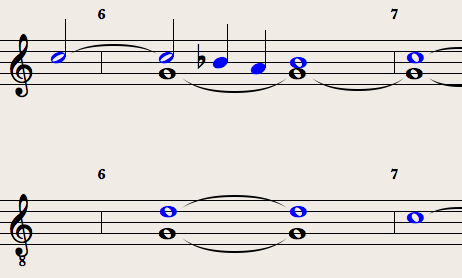
Here, the initial question is similar to above. The sixth between D and B♭ (both shewn in blue) must be 'perfected', by raising the B♭ to B♮.14 Both Fallows15 and Smijers16 confirm this in the 4 voice version (despite very different treatments of ♮ and ♭ in general), and this produces a satisfying cadence.
These measures, with the B accordingly raised in the Superius, look like this in the six voice version:
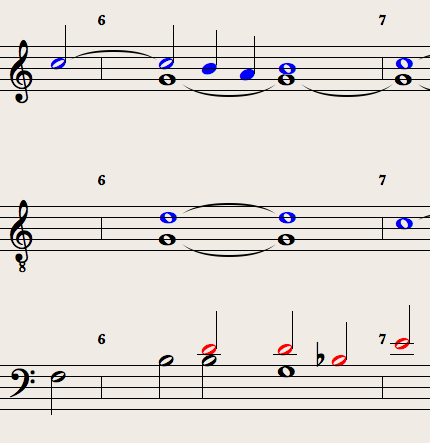
Here there are several problems, primarily pertaining to Musica Recta, rather that Musica Ficta. Notice, for instance, that the low Bassus leaps a tritone from F to♮. Aaron tells us that the♮ here must be lowered to ♭: "...the signs of b molle and b duro ... this usage is intended solely for the mitigation and temperament of the tritone. Even if b molle is not shown... it is understood that this harshness is never to be tolerated. ... Many composers have observed this rule... Josquin also confirms... this."17 Notice that the high Bassus also leaps a tritone, from B♭ to E between measures 6 and 7. If this tritone is also to be "mitigated and tempered" according to the above rule, then the B♭ will have to be raised to♮. Correcting both tritones results in this rather chromatic passage:

which is what is given by Smijers, and what is sung by Wickham. This mixture of ♮and ♭, of course, confounds the high Superius. On the one hand, singing the notated ♭ would create a diminished octave (also forbidden by Zarlino along with the augmented octave) against the high Bassus. On the other hand, singing the necessary alteration of ♭ to ♮, as previously discussed, would produce a forbidden augmented octave with the low Bassus. Wickham took the latter solution, and sang the augmented octave. Smijers, on the other hand, gives this mixed solution, containing both ♭ and ♮ in the superius:
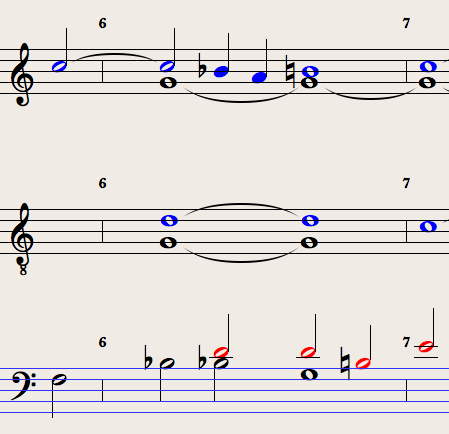
The mixture of ♭ and ♮ has, however, been forbidden since time immemorial. Pseudo-Odo of Cluny, for instance, says that "...una earum ſemper ſuperflua est, & in quoqumque cantum unam recipis, aliam contemnis, ne in eodem loco, quod abſurdum eſt, tonum & ſemitonum facere videaris" or "...one of these is always superfluous, and in any song one is accepted, the other contemned, as it would be absurd for a tone and semitone to be seen in the same place."18 Of course, this may not be as literally applicable in 1502 as it was in c902. Nonetheless, altering one note and not the other seems to undermine the first B's function as an embellishment of the resolution on the second B. Here, it does seem a little "abſurdum" to see both "in eodem loco [in the exact same place]".
Another solution for this passage may be obtained by considering the canonic structure of the work. Niccolo Vicentino talks about canonic imitation, and suggests that the comes should preserve the interval structure of the dux. Hs says "If I wish to start the imitation, I shall choose such a passage as will permit the other parts to say [that is solmize] it the same."19 Applied to Josquin, this would give the following solution:
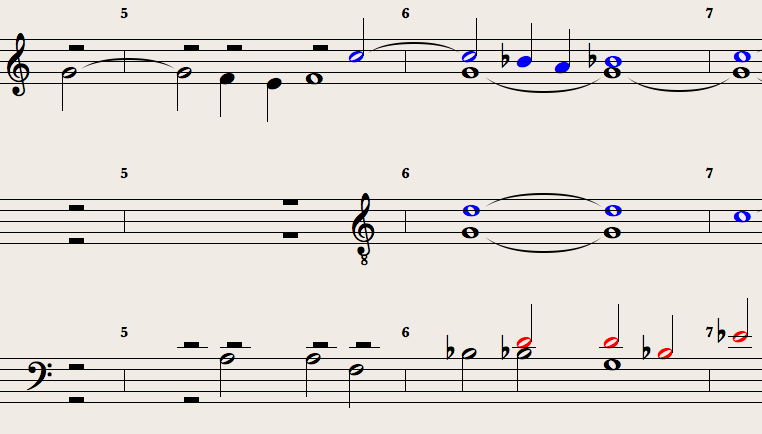
Here, the high Superius sings two ♭ s as an exact intervallic repetition of the low Superius, and the high Bassus leaps from B♭ to E♭ as an exact intervallic repetition of the low Bassus. This solution avoids both tritones and augmented/diminished octaves entirely.
To recapitulate the choices for measures 6 and 7: In the four-voice version, it seems as though the high Superius must sing a B♮. This produces a very diatonic cadence in C Lydian that sounds like a V-I cadence in C Major to modern ears. In the six-voice version, either B♮s will be mixed with B♭s, producing a highly chromatic cadence in an ambiguous mode, or all B♭s will be sung with an E♭ at the end, producing the effect of a sort-of weak 'modulation' to an ambiguous 'key'. Either way, the six-voice version will sound much different and much more chromatic than the 4-voice version.
In summary, contemporary literature indicates many places in the four-voice version of Josquin's 'Basies Moy' that must be alered chromatically. In some cases, the alterations are made to perfect sixths preceeding octaves, and in other cases to prevent melodic tritones. Many of these chromatically altered notes conflict with the additional voices when applied to the six-voice version. The altered notes either make augemented/diminished intervals with the bassus, force melodic melodic tritones in other parts, or otherwise break other rules of counterpoint in the contemporary literature. This means that chromatic alterations must be used differently in each version. These differences are extensive enough (because of the form of the piece) and at structurally-important enough places (like the final cadence) that the general, overarching character of each piece is unique.
An extra note to Dr. Schiller
In your lecture you mentioned that "The a6 version... requires Bbs so consistently that it is actually in a different mode, G Dorian, not G Mixolydian."20 I think that this is part of what you wanted this paper to explain. It turns out that the answer to this was not within the scope of my thesis, but nonetheless, I will make a brief attempt to explain it here. The problem, as I see it, is not that the six-voice version is replete with B♭s, but rather that the four-voice version is replete with B♮s. The reason for the B♮s is primarily editorial (and thus out of scope for my thesis). In the four-voice version, Petrucci writes out all four parts. The dux parts have no key signature, and, since it is a canon at the fourth, the comes parts both have a key signature of one flat. This accords with Vicentino's remark that "One should observe that when the tenor will make the canon at the fifth with the alto, if the tenor will be by the soft b, the alto will go by the hard b."21 The four-voice version in "Josquin Werken" also gives the same key signatures as Petrucci. Although I have pointed out some situations where these B♭s need to be altered, there are many other situations where they are fine in both the four and six-voice version, like here:

For reasons that I don't understand (access to other sources, perhaps), the four-voice version in NJE, which you used for your presentation, has edited these out and gives all B♮s in these measures. Notice however, that in Wickham's four-voice recording, they sing all B♭s (actually A♭s because they are transposing), while in their six-voice version (contrary to your observation) they sing B♮s in measure 14 and B♭s in measures 15 and 16. The point is that here, either flats or naturals could be sung in either version without breaking any rules. There is certainly nothing in the substance of these measures that forces naturals in the four-voice version or flats in the six-voice version. So, throughout much of the piece, whether one or the other version sounds like G Mixolydian as opposed to G Dorian just depends on what the editor gives or what the performers decide to sing.
- 4 voice version published by Petrucci in 1502
- 6 voice version published by Petrucci in 1502
- My non-edition of the Petrucci A6. The upper two staves are the corresponding voices from the 4 voice version, and the lower staff contains the voices unique to the A6. Cannonic pairs share staves, with the dux in black and the comes in color.
- My non-edition of the Petrucci A4. This can mostly be deduced from the upper two staves of my non-edition of the Petrucci A6, except where it varies in a few minor details.
- The A6 as sung by Wickham, along with a MIDI file of the same.
- The A4 as sung by Wickham, along with a MIDI file of the same.
Notes
-
If this is not self evident, it is made clear, for instance, by Johann Fux, The Study of Counterpoint, 62. Figure 49 shews:
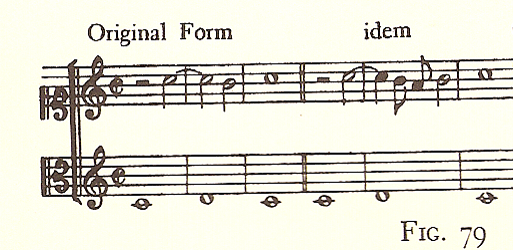
Here, Fux says: "From this one can see clearly that first and third [not shewn here] examples represent the original form; the ones respectively following where idem is added are varients used in the interest of the melodic line..." - Coussemaker, Scriptores, v.3, 73.
- Coussemaker, Scriptores v.3, 73.
- Gereberto, Scriptores v.3, 73.
- Pietro Aaron, Compendolo, chapter 66, "Del Canto Figurato".
- David Fallows, New Josquin Edition. v.28 p11.
- Zarlino, Istitutione Harmoniche Book III, pp196-197.
- Johannes Tinctoris, Concerning the Nature, p.14
- Lowinsky, "Musica Ficta in the Josquin Edition", p.780.
- Josquin Werken, 3(2):51.
- Edward Wickham, Missa Malheur me bat, Track 7 (a6), Track 4 (a4).
- Pietro Aaron, Toscanello, v.2 pt.1, chapter XVIII: 30-31.
- Here, the scholars are Margaret Bent, Counterpoint, Composition and Musica Ficta, 13. Although squabbling, she is agreeing with Lucy Cross, Chromatic Alterations and Extrahexachordal Intervals in Fourteenth-Century Polyphonic Repertories, (PhD. Dissertation, Columbia University, 1990).
- I must argue with myself on this point. I'm not actually so sure that the rule of perfecting the sixth applies to the interval D-B. The examples in the literature that I have seen all show exclusively F G and C being raised to F♯, G♯, and C♯, respectively. Furthermore, I believe that the interval F-F♯ is a semitone, and the interval B♭-B is a dieses, which is larger than a semitone by a comma of Didymus. I feel as though this topic needs more research. Either way, here, I just wanted to point out that B♮ is the common solution, and the six-voice version will require a unique treatment in any event.
- New Josquin Edition. v.28 p11.
- Josquin Werken, 3(2): 53.
- Pietro Aaron, Toscanello, v.2 pt.2: 12-13.
- Gereberto, Scriptores, v.1, 254.
- Unfortunately, our copy of L'Antica Musica Ridotta alla moderna prattica is at the bindery, so I took this from a secondary source. Nicholas Routley, A Practical Guide, p.67.
- David Schiller, MR Ch. 5 Part II.docx, 1.
- Again, a secondary source. Karol Berger, Musica Ficta, 158. from Pietro Aaron L'Antica Musica, ch.33, fol 89r-90v;
Bibliography
- Aaron, Pietro. Toscanello in Music, Books I, II and III. Translated by Peter Bergquist. Colorado Springs: Colorado College Music Press, 1970.
- Aaron, Pietro. Compendolo de Molti Dubbi, Segreti, et Sentenze Intorno al Canto Fermo, et Figurato. New York: Broude Brothers Limited. Facsimile of the 1545 edition.
- Bent, Margaret. Counterpoint, Composition, and Musica Ficta. New York: Routledge, 2002.
- Berger, Karol. Musica ficta: theorias of accidental inflections in vocal polyphony from Marchetto da Padova to Gioseffo Zarlino. Cambridge: Cambridge University Press, 1987.
- Cluny, Pseudo Odo. Enchiridion Musices Published in Gerbert, Martin Scriptores, Volume 1, pp251ff.
- Coussemaker, Charles Edmond Henri. Scriptorum de musica medii ævi. Paraisiis, 1864-76.
- Josquin des Prez. "Baisiez moy". New Josquin Edition Edited by Willem Elders et. al. Utrecht: Vereniging voor Nederlandse Muziekgeschiedenis, 1987. (27):11-12.
- Josquin des Pres. "Basiez Moy A quattro". Josquin Werken. Edited by Dr. A. Smijers. Amsterdam: G. Alsbach, 1921-1969. 3(2):53.
- Josquin des Pres. "Basies Moy A six". Josquin Werken. Edited by Dr. A. Smijers. Amsterdam: G. Alsbach, 1921-1969. 3(2):51-52.
- Fux, Johann Joseph. The Study of Counterpoint. Translated and Edited by Alfred Mann. New York: W.W. Norton and Company, 1943.
- Gereberto, Martino, ed. Scriptores Ecclesiastici de Musica Sacra Potissimum. Typis San Blasianis, 1784.
- Lowinsky, Edward E. "Musica Ficta in the Josquin Edition". Music in the culture of the Renaissance and other essays. Chicago: University of Chicago Press. 779-793.
- Muris, Jean. Ars Discantus. Published in Coussemaker Scriptores, Vol 3 pp. 71ff New Grove Dictionary of Music and Musicians. s.v. "Musica Ficta (1-4)", by Margaret Bent. Edited by Stanley Sadie and John Tyrell. London: MacMillian Publishers, 2001.
- Padua, Marchetto. Lucidarium Musicæ Planæ. Published in Gereberto Scriptores, Vol 3 pp. 73ff
- Petrucci, Ottaviano Canti B Numero Cinquanta. New York: Broude Brothers. Facsimile of the 1502 Venice edition.
- Routly, Nicholas. "A Practical Guide to Musica Ficta." Early Music 13(1): 59-71.
-
Schiller, David. MR Ch. 5 Part II.docx
http://www.elc.uga.edu/webct/urw/lc787141544011.tp803529437031. Internet: accessed 11/25/2010. Must be logged in to elc.uga.edu to access.
//RelativeResourceManager?contentID=1030456834061 - Tinctoris, Johannes. Concerning the Nature and Propriety of Tones. Translated by Albert Seay. Colorado Springs: Colorado College Music Press, 1976.
- Wickham, Edward, dir. Missa Malheur me bat; Motets & chansons; Liber generationis Jesu Christi, by Josquin des Prez. Clerks' Group. CD GAU 306.
- Zarlino, Gioseffo. The art of counterpoint. Part three of Le istitutioni harmoniche, 1558. Translated by Guy A. Marco and Claude V. Palisca. New Haven: Yale University Press, 1968.